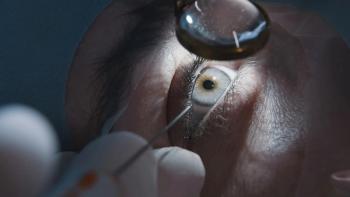
Case report: Combination treatment proves effective for choroidal metastasis from breast cancer patient
According to the authors, a patient with bilateral choroid metastases from breast cancer experienced "a dramatic response" after a combination treatment of abemaciclib and fulvestrant.
The combination treatment of abemaciclib and fulvestrant (estrogen receptor antagonist) provided a “dramatic response” in a patient with bilateral choroid metastases from breast cancer,1 according to senior author Carol Shields, MD, from the Ocular Oncology Service, Wills Eye Hospital, Thomas Jefferson University, Philadelphia.
She and colleagues previously assessed 1,111 consecutive patients with uveal metastasis and found that breast cancer represented 37% of cases.2 In that same patient cohort, Welch et al.3 reported a mean interval of 6.5 years between the diagnosis of primary breast cancer and development of uveal metastasis.
Case report
A woman in her sixth decade of life was diagnosed with hormone receptor–positive and ERBB negative (HR+/ERBB−) invasive ductal breast carcinoma that metastasized to the lungs, brain, and spine. The patient also reported visual loss that examination showed was the result of a retinal detachment with choroidal metastases bilaterally.
The best-corrected visual acuities (BCVAs) were light perception and 20/50 in the right and left eyes, respectively. A total exudative retinal detachment with 1 large diffuse choroidal metastasis was seen in the posterior pole of the right eye and multifocal choroidal metastases (largest, 11 mm in basal diameter) in the left eye.
Ultrasonography confirmed a total serous retinal detachment and diffuse 2.5-mm choroidal thickening in the right eye and multifocal choroidal thickening in the left eye. Bilateral choroidal metastases were diagnosed, and the metastatic breast cancer was treated with systemic oral abemaciclib 150 mg twice daily, and fulvestrant 500 mg intramuscular injection monthly. The abemaciclib dose was later reduced to 100 mg orally twice daily because of nausea, diarrhea, and anorexia.
Four months after the start of treatment, the metastases regressed with almost complete resolution of the retinal detachment in the right eye; the BCVAs improved to 20/50 and 20/20 in the right and left eyes, respectively, Shields reported.
A previous study4 reported that abemaciclib is a selective small-molecule inhibitor of cyclin-dependent kinases 4 and 6 that is a treatment option for HR+/ERBB2− breast cancer. The authors reported that abemaciclib plus fulvestrant significantly extended the progression-free survival compared with fulvestrant alone (median, 16.4 vs. 9.3 months; hazard ratio, 0.553; 95% confidence interval, 0.449-0.681; p < 0.001).
Regarding the current case, Shields commented, “We cannot be certain of the results in similar presentations or what effects will be noted beyond 4 months. In this report, we observed substantial regression of bilateral choroidal breast cancer metastases in a single case followed through 4 months with resolution of a total exudative retinal detachment in 1 eye without ocular radiotherapy.”
References
Barke MR, Agraal KU, Shields CL. Abemaciclib and fulvestrant for bilateral choroidal metastasis from breast carcinoma. JAMA Ophthalmol. Published online September 8, 2022. doi:10.1001/jamaophthalmol.2022.3453
Shields CL, Welch RJ, Malik K, et al. Uveal metastasis: clinical features and survival outcome of 2214 tumors in 1111 patients based on primary tumor origin. Middle East Afr J Ophthalmol. 2018;25(2):81-90. doi:
10.4103/meajo.MEAJO_6_18 Welch RJ, Malik K, Mayro EL, et al. Uveal metastasis in 1111 patients: interval to metastasis and overall survival based on timing of primary cancer diagnosis. Saudi J Ophthalmol. 2019;33(3):229-237. doi:
10.1016/j.sjopt.2019.07.006 Sledge GW Jr., Toi M, Neven P, et al. MONARCH 2: Abemaciclib in combination with fulvestrant in women With HR+/HER2—advanced breast cancer who had progressed while receiving endocrine therapy. J Clin Oncol. 2017;35(25):2875-2884. doi:
10.1200/JCO.2017.73.7585
Newsletter
Want more insights like this? Subscribe to Optometry Times and get clinical pearls and practice tips delivered straight to your inbox.













































